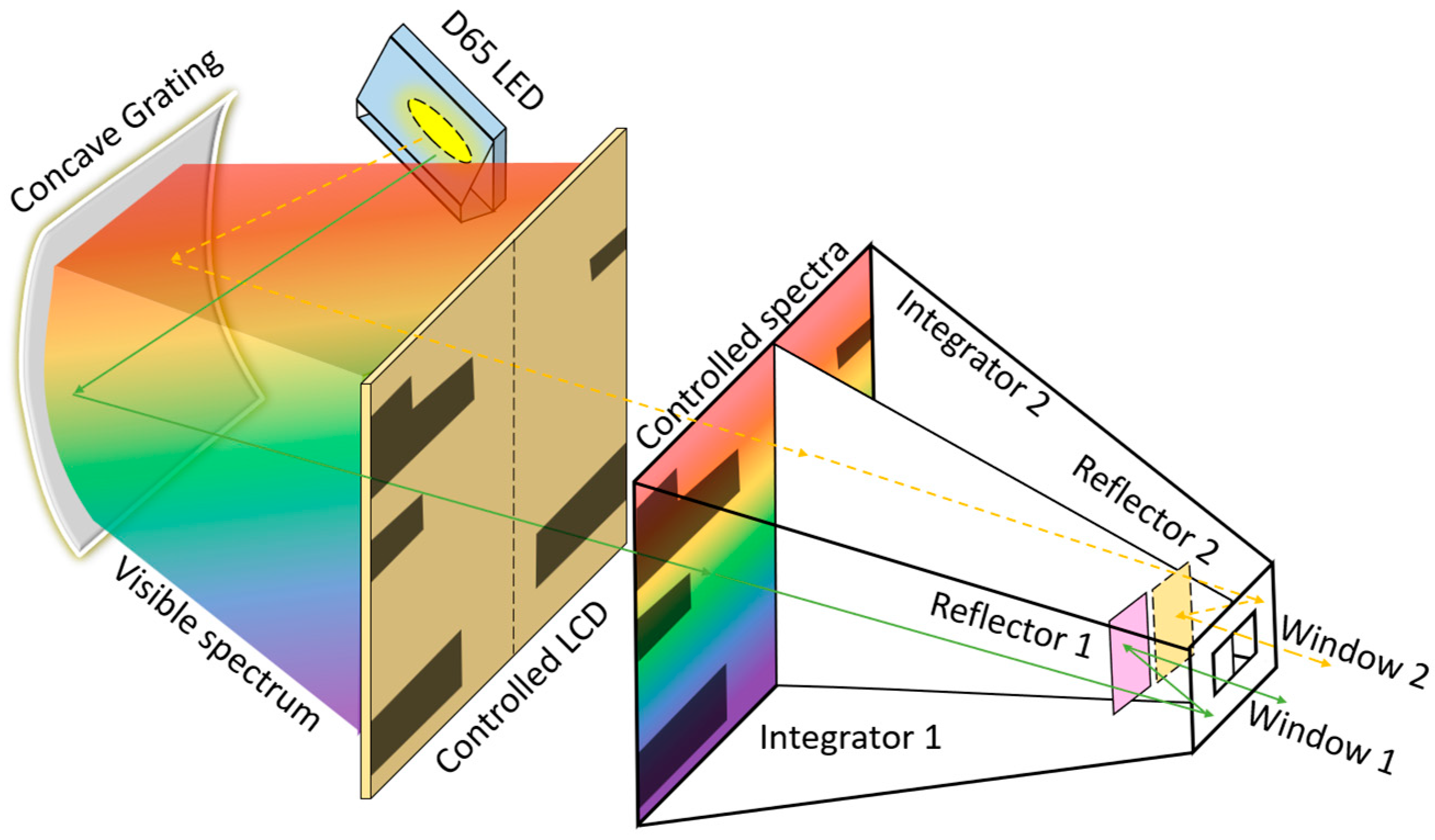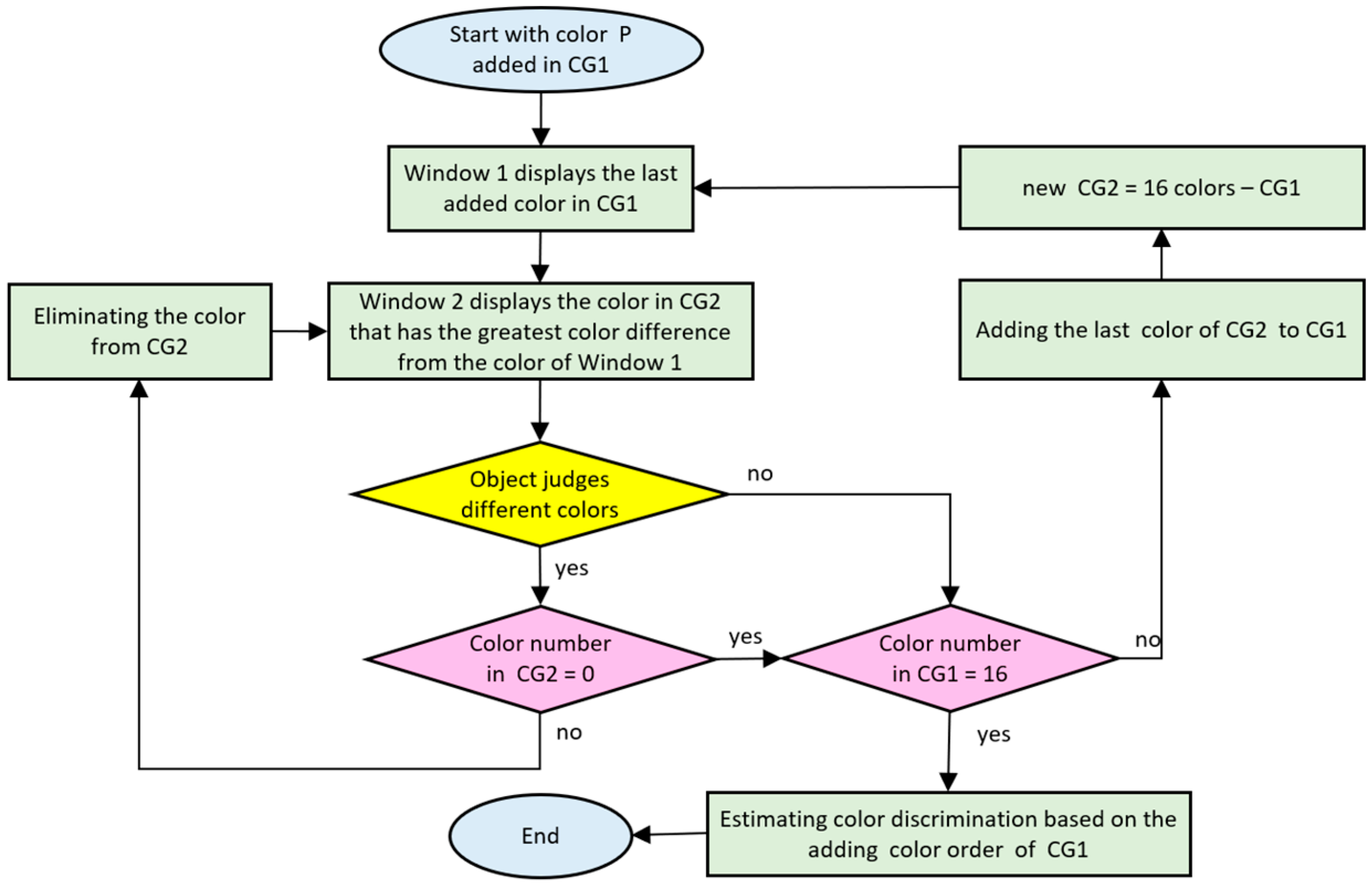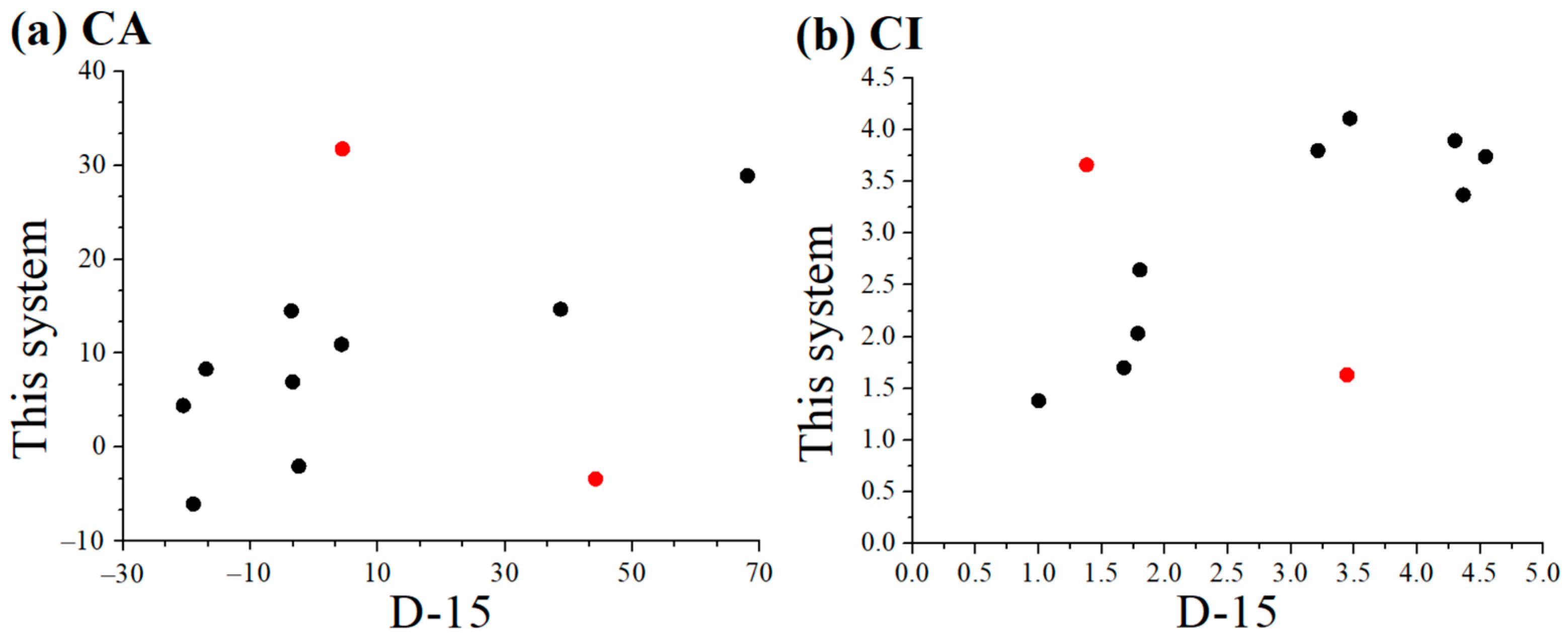Computerized Full-Color Assessment for Distinguishing Color Vision Deficiency
Abstract
1. Introduction
2. Materials and Methods
2.1. Patient Selection
2.2. Classical D-15 Method
2.3. Full-Color Light Generation System
2.4. Procedure for Conducting the CFCA Test
2.5. Data Analysis
3. Results
3.1. Full-Color Light Generation System in the CFCA Method
3.2. Normal Trichromats Assessed with the D-15 and CFCA Methods
3.3. Patients with CVDs Assessed with the D-15 and CFCA Methods
3.4. Statistical Analysis Between Two Tests
4. Discussion
4.1. The CFCA Method with Full-Color Light Generation System
4.2. Assessment of Normal Trichromats
4.3. Assessment of CVD Patients
4.4. Comparison with Other Methods for Identifying CVDs
5. Conclusions
Author Contributions
Funding
Institutional Review Board Statement
Informed Consent Statement
Data Availability Statement
Acknowledgments
Conflicts of Interest
References
- Wachtler, T.; Dohrmann, U.; Hertel, R. Modeling color percepts of dichromats. Vis. Res. 2004, 44, 2843–2855. [Google Scholar] [CrossRef]
- Simunovic, M.P. Acquired color vision deficiency. Surv. Ophthalmol. 2016, 61, 132–155. [Google Scholar] [CrossRef]
- Webster, M.A.; Mollon, J.D. Changes in colour appearance following post-receptoral adaptation. Nature 1991, 349, 235–238. [Google Scholar] [CrossRef]
- Hart, W.M., Jr. Acquired dyschromatopsias. Surv. Ophthalmol. 1987, 32, 10–31. [Google Scholar] [CrossRef]
- Yang, Z.H.; Yan, L.; Zhang, W.L.; Qi, J.; An, W.J.; Yao, K. Dyschromatopsia: A comprehensive analysis of mechanisms and cutting-edge treatments for color vision deficiency. Front. Neurosci. 2024, 18, 1265630. [Google Scholar] [CrossRef]
- Almustanyir, A. A Global Perspective of Color Vision Deficiency: Awareness, Diagnosis, and Lived Experiences. Healthcare 2025, 13, 2031. [Google Scholar] [CrossRef]
- Hardy, L.H.; Rand, G.; Rittler, M.C. Tests for detection and analysis of color blindness; an evaluation of the Ishihara test. Arch. Ophthalmol. 1945, 34, 295–302. [Google Scholar] [CrossRef]
- Farnsworth, D. The Farnsworth-Munsell 100-hue and dichotomous tests for color vision. J. Opt. Soc. Am. 1943, 33, 568–578. [Google Scholar] [CrossRef]
- Dain, S.J.; Atchison, D.A.; Hovis, J.K. Limitations and Precautions in the Use of the Farnsworth-Munsell Dichotomous D-15 Test. Optom. Vis. Sci. 2019, 96, 695–705. [Google Scholar] [CrossRef]
- SCHMIDT, I. Some problems related to testing color vision with the Nagel anomaloscope. J. Opt. Soc. Am. 1955, 45, 514–522. [Google Scholar] [CrossRef]
- Cosstick, M.; Robaei, D.; Rose, K.; Rochtchina, E.; Mitchell, P. Numerical confusion errors in Ishihara testing: Findings from a population-based study. Am. J. Ophthalmol. 2005, 140, 154–156. [Google Scholar] [CrossRef]
- Almustanyir, A.; Alduhayan, R.; Alhassan, M.; Bokhary, K.; Alabdulkader, B. Evaluation of the Waggoner computerized D15 color vision test using an iPad device. J. Opt. Soc. Am. A Opt. Image Sci. Vis. 2021, 38, 1647–1655. [Google Scholar] [CrossRef]
- Ng, J.S.; Self, E.; Vanston, J.E.; Nguyen, A.L.; Crognale, M.A. Evaluation of the Waggoner Computerized Color Vision Test. Optom. Vis. Sci. 2015, 92, 480–486. [Google Scholar] [CrossRef]
- Almustanyir, A.; Alhazmi, M.; Aldarwesh, A.; Almutairi, M.S.; Almahubi, M.; Alateeq, A.; Alqahtani, T.; Alanazi, M.; Alotaibi, S.; Alghamdi, M.; et al. Age-Related Effects on the Color Discrimination Threshold. Life 2025, 15, 1074. [Google Scholar] [CrossRef]
- Honnell, V.; Bonci, D.; Barboni, M.T.S.; Gualtiere, M.; Bastos, A.; Rego, L.; Souza, G.S.; Fitzgerald, M.E.C.; Silveira, L.C.L.; Ventura, D.F. Genetic analysis, the Color Assessment and Diagnosis (CAD) test, and the Cambridge Color Test (CCT) yield the same color vision classifications in humans. Investig. Ophthalmol. Vis. Sci. 2015, 56, 3905. [Google Scholar]
- Somers, L.P.; Franklin, A.; Bosten, J.M. Empirical tests of the effectiveness of EnChroma multi-notch filters for enhancing color vision in deuteranomaly. Vis. Res. 2024, 218, 108390. [Google Scholar] [CrossRef]
- Somers, L.P.; Bosten, J.M. Predicted effectiveness of EnChroma multi-notch filters for enhancing color perception in anomalous trichromats. Vis. Res. 2024, 218, 108381. [Google Scholar] [CrossRef]
- Marques, D.N.; Gomes, A.E.; Linhares, J.M.M.; Nascimento, S.M.C. Discrimination of natural colors in anomalous trichromacy and the effects of EnChroma and Vino filters. Opt. Express 2023, 31, 18075–18087. [Google Scholar] [CrossRef]
- Gómez-Robledo, L.; Valero, E.M.; Huertas, R.; Martínez-Domingo, M.A.; Hernández-Andrés, J. Do EnChroma glasses improve color vision for colorblind subjects? Opt. Express 2018, 26, 28693–28703. [Google Scholar] [CrossRef]
- Hsu, J.C. Color-Light Generation System and Method of Using the Same. U.S. Patent 11,934,014, 19 March 2024. [Google Scholar]
- Fan, F.L.; Wu, Y.F.; Tang, D.Y.; Shu, Y.J.; Deng, Z.; Xin, H.; Liu, X.Q. Evaluation of SeeColors filters for color vision correction and comparative analysis with EnChroma glasses. Displays 2024, 85, 102831. [Google Scholar] [CrossRef]
- Vingrys, A.J.; Atchison, D.A.; Bowman, K.J. The use of colour difference vectors in diagnosing congenital colour vision deficiencies with the Farnsworth-Munsell 100-hue test. Ophthalmic Physiol. Opt. 1992, 12, 38–45. [Google Scholar] [CrossRef] [PubMed]
- Vingrys, A.J.; King-Smith, P.E. A quantitative scoring technique for panel tests of color vision. Investig. Ophthalmol. Vis. Sci. 1988, 29, 50–63. [Google Scholar]
- Schober, P.; Boer, C.; Schwarte, L.A. Correlation Coefficients: Appropriate Use and Interpretation. Anesth. Analg. 2018, 126, 1763–1768. [Google Scholar] [CrossRef]
- Clarke, W. ; American Association for Clinical Chemistry. Contemporary Practice in Clinical Chemistry, 3rd ed.; AACC Press: Washington, DC, USA, 2016; p. xiv. 815p. [Google Scholar]
- Evans, B.E.W.; Rodriguez-Carmona, M.; Barbur, J.L. Color vision assessment-1: Visual signals that affect the results of the Farnsworth D-15 test. Color Res. Appl. 2021, 46, 7–20. [Google Scholar] [CrossRef]
- Birch, J. Failure of concordance of the Farnsworth D15 test and the Nagel anomaloscope matching range in anomalous trichromatism. Vis. Neurosci. 2008, 25, 451–453. [Google Scholar] [CrossRef]
- Walsh, D.V.; Robinson, J.; Jurek, G.M.; Capó-Aponte, J.E.; Riggs, D.W.; Temme, L.A. A Performance Comparison of Color Vision Tests for Military Screening. Aerosp. Med. Hum. Perf. 2016, 87, 382–387. [Google Scholar] [CrossRef]
- Klinke, T.; Hannak, W.; Böning, K.; Jakstat, H. A Comparative Study of the Sensitivity and Specificity of the Ishihara Test With Various Displays. Int. Dent. J. 2024, 74, 892–896. [Google Scholar] [CrossRef]
- Zhang, N.; Yang, J.; Hu, M.S.; Liu, Z.Y. Diagnostic performance of color vision tests for color vision deficiency: A network meta-analysis on comparisons of multiple color vision tests. Int. Ophthalmol. 2025, 45, 208. [Google Scholar] [CrossRef]
- Almustanyir, A.; Alduhayan, R.; Alhassan, M.; Bokhary, K.; Alabdulkader, B. Quantitative scoring methods of the Farnsworth D15 and Waggoner computerized D15 color vision tests in clinical practice. Color Res. Appl. 2021, 46, 1194–1204. [Google Scholar] [CrossRef]
- Almustanyir, A.; Hovis, J.; Glaholt, M.G. Predicting the Farnsworth-Munsell D15 and Holmes-Wright-A lantern outcomes with computer-based color vision tests. J. Opt. Soc. Am. A 2020, 37, A1–A10. [Google Scholar] [CrossRef]







| Normal | Sex | Age | HTN * | DM * | Patient | Sex | Age | HTN * | DM * |
|---|---|---|---|---|---|---|---|---|---|
| 1 | F | 27 | No | No | 1 | M | 39 | No | No |
| 2 | F | 59 | No | No | 2 | M | 19 | No | No |
| 3 | F | 29 | No | No | 3 | M | 29 | No | No |
| 4 | F | 26 | No | No | 4 | M | 26 | No | No |
| 5 | F | 29 | No | No | 5 | M | 16 | No | No |
| 6 | F | 41 | No | No | 6 | M | 19 | No | No |
| 7 | F | 29 | No | No | 7 | M | 9 | No | No |
| 8 | F | 25 | No | No | 8 | M | 25 | No | No |
| 9 | F | 26 | No | No | 9 | M | 24 | No | No |
| 10 | F | 28 | No | No | 10 | M | 25 | No | No |
| 11 | M | 68 | No | No |
| Patient | D-15 | CFCA | ||||
|---|---|---|---|---|---|---|
| CA | CI | Type | CA | CI | Type | |
| 1 | 68.05° | 1.79 | Protan | 28.88° | 2.03 | Protan |
| 2 | 44.22° | 1 | Normal | −3.36° | 1.38 | Normal |
| 3 | −18.98° | 3.47 | Deutan | −6.04° | 4.11 | Deutan |
| 4 | −2.38° | 3.44 | Deutan | −2.03° | 1.63 | Deutan |
| 5 | −3.58° | 4.54 | Deutan | 14.51° | 3.74 | Protan |
| 6 | 4.44° | 1.68 | Protan | 31.75° | 1.70 | Protan |
| 7 | 38.73° | 1.80 | Protan | 14.69° | 2.64 | Protan |
| 8 | −20.55° | 3.21 | Deutan | 4.45° | 3.80 | Protan |
| 9 | −16.96° | 4.37 | Deutan | 8.32° | 3.37 | Protan |
| 10 | −3.36° | 1.38 | Normal | 6.95° | 3.66 | Protan |
| 11 | −4.27° | 4.30 | Deutan | 10.95° | 3.90 | Protan |
| Mean with SD | 7.76 ± 29.3 | 2.81 ± 1.32 | 9.92 ± 12.2 | 2.91 ± 1.01 | ||
| IQR | 55.69 | 2.62 | 16.72 | 2.1 | ||
| Mean with SD excluding 4 and 10 | 10.1 ± 32.2 | 2.91 ± 1.36 | 11.6 ± 12.8 | 2.96 ± 1.05 | ||
| IQR excluding 4 and 10 | 59.45 | 2.6 | 21.24 | 2.0 | ||
| Detection Method Comparison | Nagel Anomaloscope † | Ishihara | FM-100 | D-15 | CCV | CFCA |
|---|---|---|---|---|---|---|
| Published year | 1907 | 1917 | 1940s | 1940s | 2010s | 2023 |
| Full-color gamut | No | Possible $ | Possible $ | Possible $ | Not Fully | Yes |
| Non-metameric light | Unnecessary | Possible $ | Possible $ | Possible $ | No | Yes |
| Time control | No | No | No | No | Possible | Yes |
| Short test time | No | Yes | No | Possible | Yes | Yes |
| Digitization | Possible | Poor | Poor | Poor | Yes | Yes |
| Non-memorable | Yes | Poor | Yes | Yes | Yes | Yes |
| Easy to use | Poor | Possible * | Poor | Poor | Possible | Yes |
| False negative prevention | Possible | Poor | Poor | Poor | Possible | Yes |
Disclaimer/Publisher’s Note: The statements, opinions and data contained in all publications are solely those of the individual author(s) and contributor(s) and not of MDPI and/or the editor(s). MDPI and/or the editor(s) disclaim responsibility for any injury to people or property resulting from any ideas, methods, instructions or products referred to in the content. |
© 2025 by the authors. Licensee MDPI, Basel, Switzerland. This article is an open access article distributed under the terms and conditions of the Creative Commons Attribution (CC BY) license (https://creativecommons.org/licenses/by/4.0/).
Share and Cite
Hsu, J.-C.; Tsai, C.-Y.; Shih, C.-H.; Huang, S.-R.; Wu, H.-Y.; Sun, Y.-S. Computerized Full-Color Assessment for Distinguishing Color Vision Deficiency. Diagnostics 2025, 15, 2837. https://doi.org/10.3390/diagnostics15222837
Hsu J-C, Tsai C-Y, Shih C-H, Huang S-R, Wu H-Y, Sun Y-S. Computerized Full-Color Assessment for Distinguishing Color Vision Deficiency. Diagnostics. 2025; 15(22):2837. https://doi.org/10.3390/diagnostics15222837
Chicago/Turabian StyleHsu, Jin-Cherng, Chia-Ying Tsai, Chih-Hsuan Shih, Shao-Rong Huang, Hsing-Yu Wu, and Yung-Shin Sun. 2025. "Computerized Full-Color Assessment for Distinguishing Color Vision Deficiency" Diagnostics 15, no. 22: 2837. https://doi.org/10.3390/diagnostics15222837
APA StyleHsu, J.-C., Tsai, C.-Y., Shih, C.-H., Huang, S.-R., Wu, H.-Y., & Sun, Y.-S. (2025). Computerized Full-Color Assessment for Distinguishing Color Vision Deficiency. Diagnostics, 15(22), 2837. https://doi.org/10.3390/diagnostics15222837








